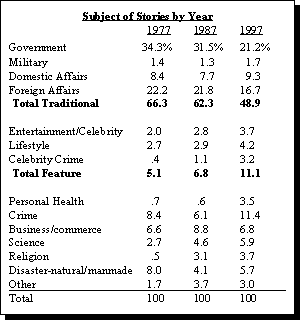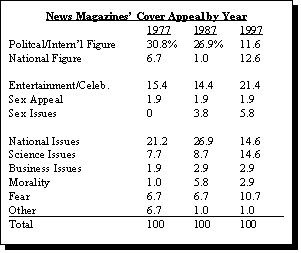The first part of the study compared coverage from 1977, 1987 and 1997 in seven media outlets. It looked at all the coverage on the three main network newscasts for one month (March) of each of those years, as well as the front page coverage of the New York and Los Angeles Times, and the cover stories in Time and Newsweek for the entire years of 1977, 1987 and 1997, some 3,760 stories in all.
The second part looked at 15 media outlets over six weeks in the fall of 1997, the three nightly newscasts, every prime time network news magazine, every story in Time and Newsweek and five newspapers’ front page coverage, some 2,260 stories in all.
In both parts of the study, we examined the stories according to two basic categories. What were they about (subjects such as government, entertainment, foreign affairs)? And what was the theme emphasized in the story (themes such as personality, lifestyle, policy, war, political process)?
A Shift in Emphasis
Twenty years ago, coverage was dominated by straight news accounts of events–what happened yesterday. Today, the news tends to have a more mediated or thematic approach to stories. In 1977, more than half of all stories (52%) were basically straight news accounts of what had happened. By 1997, that figure had fallen to less than one in three stories (32%), a 40% drop.
The thematic emphasis of stories today has moved away from such concerns as the political process, war and peace, policy and from updating or analyzing in depth continuing events–what might be called traditional news emphasis. The emphasis on people, human interest and news you can use. There is also a new emphasis on scandal, the bizarre and fear about the future. For instance, in 1977, stories with a traditional news emphasis outweighed stories with a feature or scandal emphasis by two to one, 32% traditional versus 15% feature. (See table.)
Twenty years later, that relationship was essentially reversed. Only one in four stories concerned these traditional hard news themes while more than four in ten emphasized the softer or more sensational themes.
Story Topics

If you look at simply what the stories were about–the subject rather than the thematic emphasis–there are similar shifts.
The number of stories about government dropped by 38% from 1977 to 1997, from one in three stories to one in five, still a sizable number, but lower.
The number of stories about foreign affairs dropped by 25%, from nearly one in four stories to about one in every six.
The number of stories about celebrity, entertainment or celebrity crime tripled from one in every 50 stories to one out of every 14; the total number is still not huge, but it is rising.
The news media also began covering other topics more. Coverage of science, religion and also rose, though not to particularly high numbers, less than one in ten combined.
Clearly these shifts in topic and thematic emphasis represent the media covering a broader spectrum of news, searching for new relevant topics in the face of declining audience share.
One question not answered here is whether that broadening is helping to provide audiences with more of the information they require in a democratic society or whether we are moving too far in the direction of amusement.
News Magazine Cover Appeal

We also found, looking at the covers of the news magazines themselves, that there has been a change in the way stories are sold to readers. Serious topics are sometimes presented through a Hollywood prism. Brad Pitt fronts a story about Buddhism in Time; Robin Williams fronts a story about brain research in Newsweek, coinciding with his role as a mad professor in the recent movie Flubber, though the story says nothing about the movie or Robin Williams. It was unclear in some instances whether there was a real predicate for some of these stories. Was there really a move toward Buddhism in America, or was this a way of putting Brad Pitt on the cover? Why not Islam rather than Buddhism, which is a larger, growing religion in America?
In 1977, political or international figures represented nearly one in three of all the Time and Newsweek covers. By 1997, that number fell by more than 60% to one in ten covers. Interestingly, much of that shift occurred between 1987 and 1997.
Covers that sold the story with celebrities, a sexy man or woman or an image story about sex itself doubled from 1977 to 1997, from one in six one in three. Covers about new ideas in science doubled from 1977 to 1997, from 8% of covers to 15%. Interestingly, covers about people who were not necessarily leaders but who had become known, perhaps momentarily, such as the parents of septuplets, nearly doubled from 7% to 13%.
The shift toward celebrity can be seen by another benchmark as well. Time and Newsweek had the same cover as People magazine seven times as often in 1997 as in 1977. Interestingly, People moved away from celebrity and entertainment somewhat over the last twenty years, with seven trend or news covers in 1997, versus none twenty years ago. Yet only one of those did it have in common with Time and Newsweek, the cult mass suicide in Southern California.